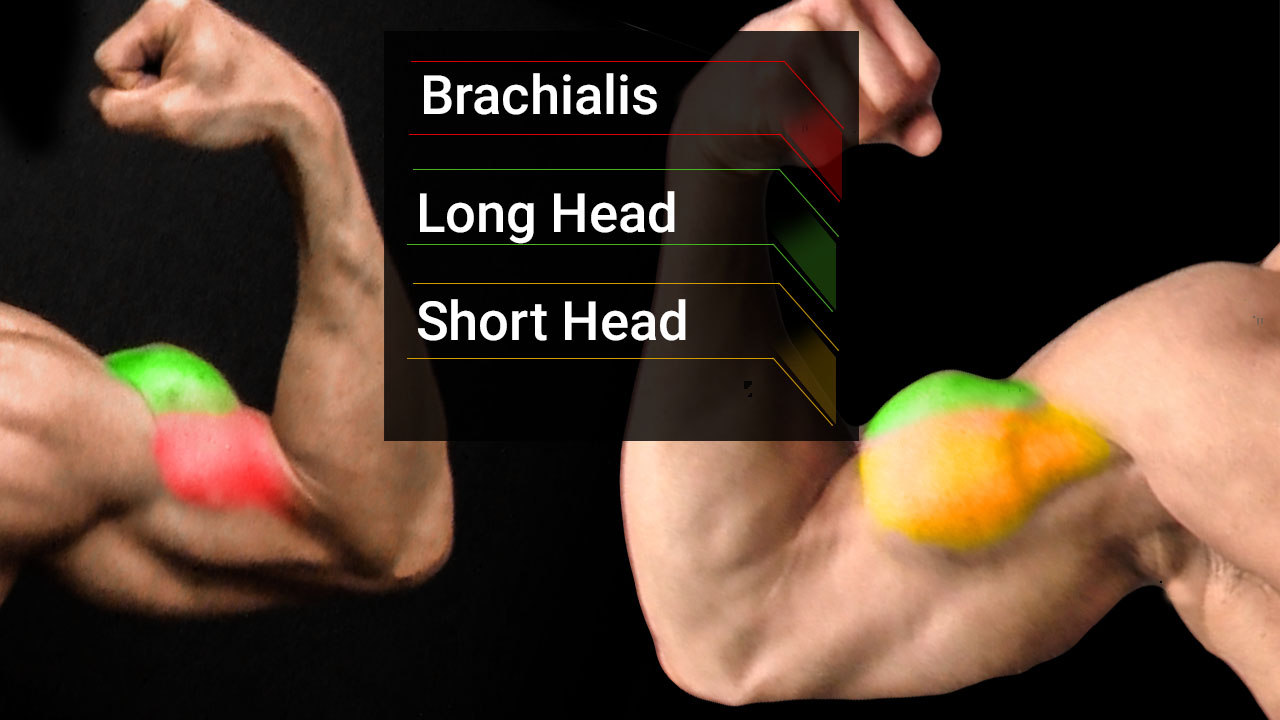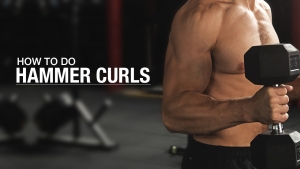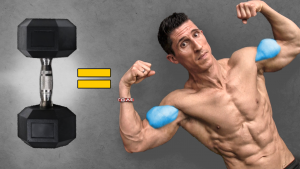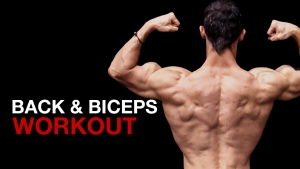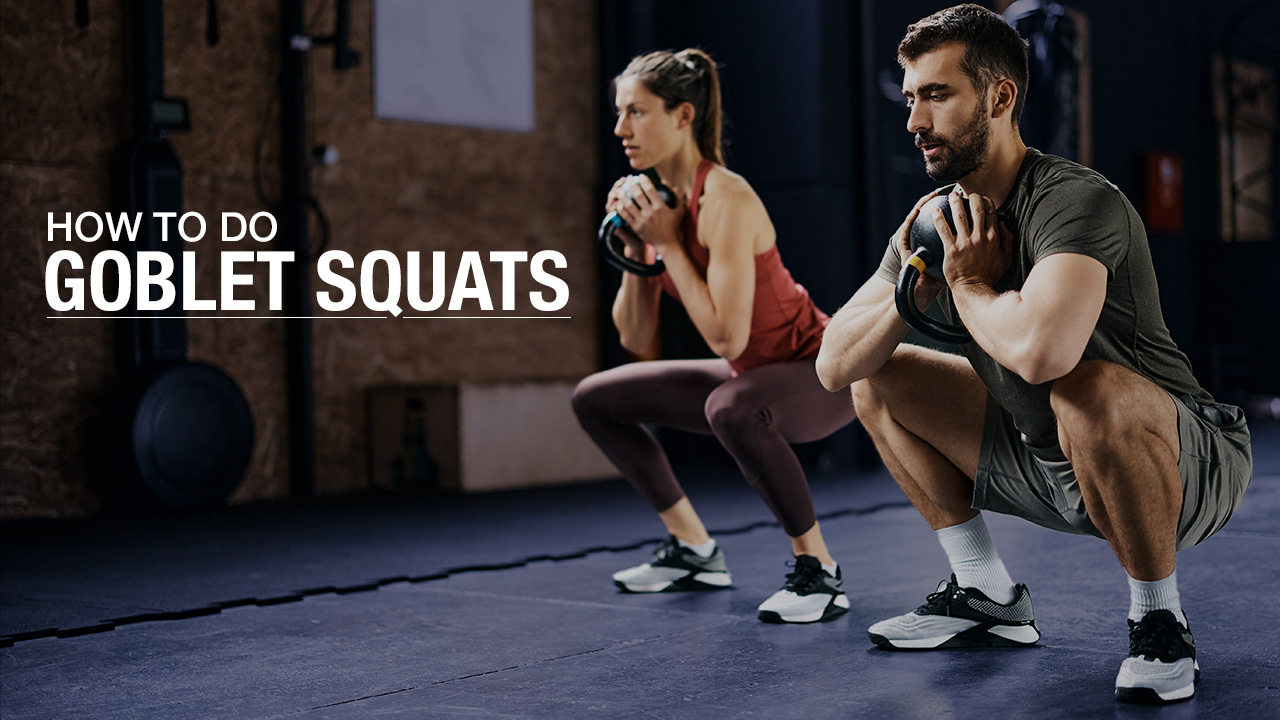
ARE YOU DOING BICEP CURLS CORRECTLY?
If you think bicep curls are just about lifting weights up and down, you’re missing out on their full potential.
Whether you’re aiming for arm size, strength, or definition, the Bicep Curl is a fundamental exercise that can deliver serious results—if done correctly.
This isn’t just about grabbing a pair of dumbbells and curling away.
It’s about understanding the nuances of the movement, engaging the right muscles, and avoiding common pitfalls that can derail your progress and lead to injury.
In this article, we’re diving deep into how to perform bicep curls with precision, breaking down the form, technique, and variations that will transform your arm workouts and take your gains to the next level.
ANATOMY OF THE BICEPS
Understanding the muscle groups that make up your biceps isn’t just for biology students—it’s important for anyone serious about building stronger, more defined arms.
Achieving a strong mind-to-muscle connection is essential for maximizing muscle growth and preventing injury.
By learning how each muscle in your biceps works, you can fine-tune your workouts to target them more effectively.
Let’s dive right into the biceps brachii, the superstar of bicep muscles.
This single muscle is split into two heads: the short head and the long head.
BICEPS BRACHII: SHORT HEAD

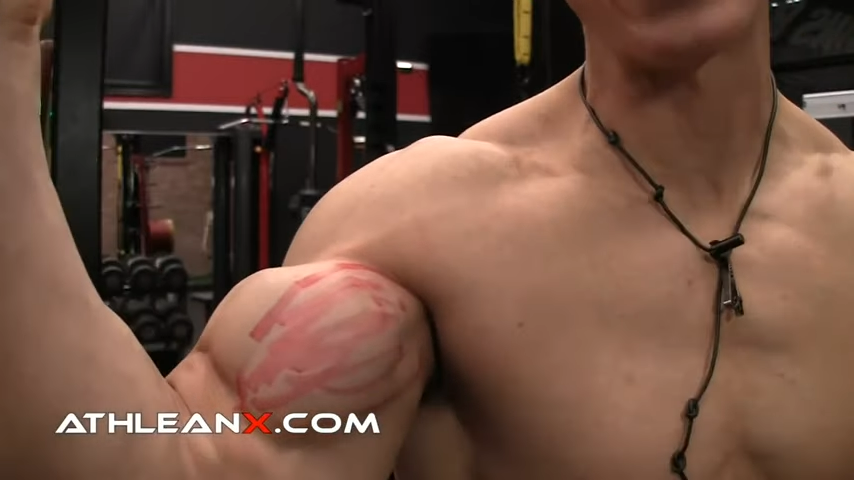
The short head is the inner part of your biceps, closer to your body.
It originates from a small bump on the shoulder blade, playing a crucial role in elbow flexion.
This movement draws your forearm towards your upper arm, key in any curl variation you perform, whether it’s a Hammer Curl or a Regular Curl.
The activity of biceps brachii also assists in supination, turning your forearm into a palm-up position – think of the classic twist in a Dumbbell Curl.
Additionally, it pitches in to help lift your arm forward, contributing to shoulder flexion.
This head’s multi-functional capabilities make it indispensable for a complete arm workout.
BICEPS BRACHII: LONG HEAD

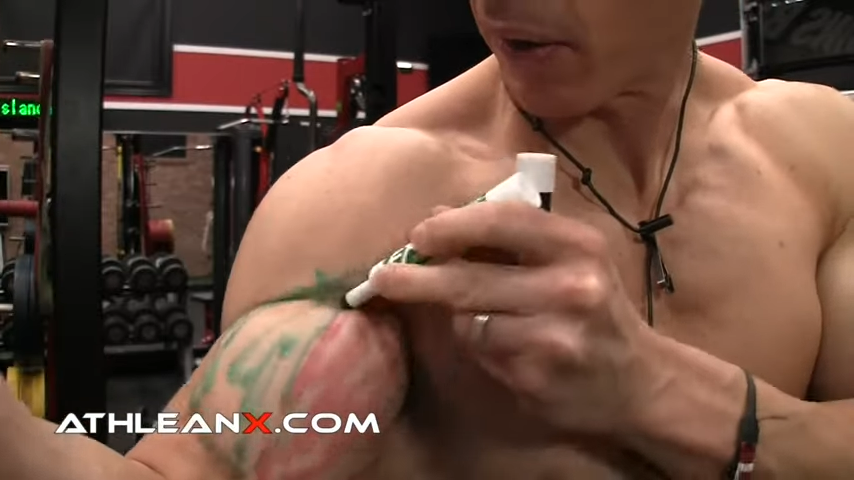
Now, let’s talk about the long head of the biceps brachii, the outer part that gives your arm that defined peak.
Originating from the supraglenoid tubercle of the scapula, it travels through the bicipital groove over the shoulder joint.
This unique positioning makes it essential for several movements.
Primarily, the long head is responsible for elbow flexion, just like the short head, but it also significantly contributes to supination.
Ever noticed the twist at the top of your Barbell Bicep Curls? That’s the long head in action, ensuring your forearm rotates effectively.
Moreover, the long head aids in shoulder flexion, helping lift your arm to shoulder height.
It also stabilizes the shoulder joint during various upper-body movements, ensuring your shoulder stays secure during heavy lifting. This stability is crucial in preventing potential injuries during your workouts.
BRACHIALIS

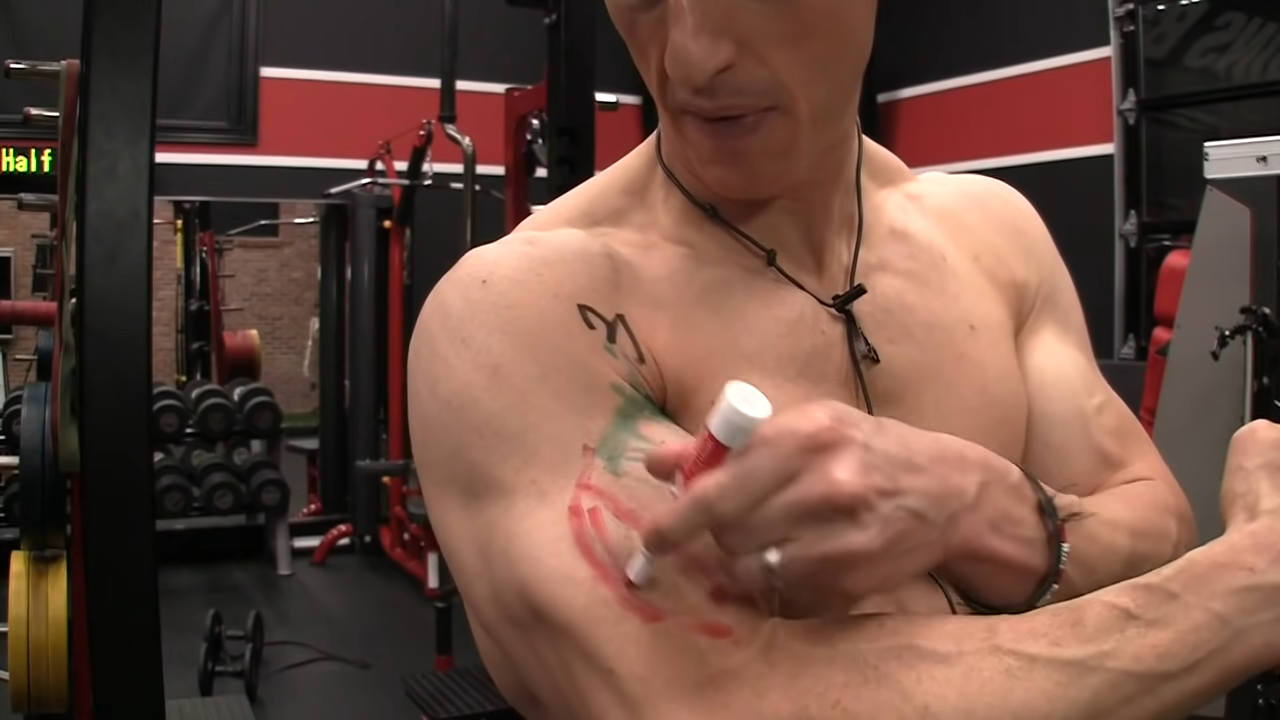
Let’s address one thing right away: The brachialis is not – technically speaking – a part of the biceps muscle.
But there’s an important reason why we need to talk about it: it can be the difference between mediocre and huge gains.
This muscle runs from the lower part of your upper arm to the elbow and assists in elbow flexion.
In fact, it’s more specialized in this action than the biceps themselves, making it a key player in any curl.
Every time you bend your elbow, the brachialis kicks in, regardless of the hand or forearm position.
This muscle also stabilizes the elbow joint, ensuring smooth and coordinated movements during your workouts.
By targeting the brachialis muscle, you can see serious size gains, ensuring more well-rounded arms (and tighter shirt sleeves).
FOREARMS
Again, the forearms aren’t technically a part of the biceps muscle group, but they play an important role in every biceps exercise you do.
More importantly, you’d never want to build bigger biceps and ignore the forearms.
This will lead to muscle imbalances in both strength and aesthetics.
The forearms extend from the elbow to the wrist and they are crucial in daily activities and during exercises like the Hammer Curl.
Your forearm muscles are the main contributors to grip strength.
Whether you’re lifting heavy weights, carrying groceries, or shaking hands, these muscles are crucial for maintaining a strong grip.
Additionally, wrist movements such as typing, writing, or waving involve the forearm muscles to move your wrists efficiently.
Fine motor skills, like buttoning a shirt or playing an instrument, also rely heavily on the intricate movements controlled by the forearm muscles.
HOW TO DO BICEP CURLS
Bicep Curls are a fundamental exercise for building arm strength and muscle growth.
Mastering the proper form and technique is crucial to maximize the effectiveness of your workout and prevent potential injuries.
This section will guide you through the steps of performing bicep curls with precision and control, ensuring you target the biceps brachii effectively and engage supporting muscles like the brachialis and forearm muscles.
DUMBBELL BICEP CURLS

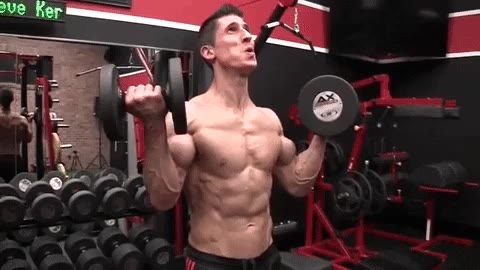
HOW TO DO THE DUMBBELL BICEPS CURL:
- Stand with your feet shoulder-width apart.
- Hold a pair of dumbbells or a barbell with an underhand grip, arms fully extended and palms facing forward.
- Keep your elbows close to your torso, ensuring they remain static throughout the movement.
- Maintain a straight posture with your chest up and core muscles engaged.
- Use lighter weights initially to master the proper form before progressing to heavier weights.
- Begin the curl by flexing your elbows, lifting the weights towards your shoulders in a smooth and controlled motion.
- Focus on the activity of the biceps brachii, emphasizing muscle activation and minimizing any shoulder or body movement.
- Raise the weights until your biceps are fully contracted, and the dumbbells are at shoulder height.
- Squeeze your biceps at the top of the movement for maximum muscle stimulus.
- Slowly lower the weights back to the starting position, maintaining control to keep tension on the muscle fibers.
- Avoid letting the weights drop quickly to prevent form breaks and potential injury.
WHAT MAKES IT EFFECTIVE: This movement keeps both biceps under continuous tension, enhancing muscle engagement and metabolic conditioning. This simultaneous action promotes greater muscle growth, strength, and endurance compared to alternating curls.
BICEP CURLS: COMMON MISTAKES
Even the simplest exercises can be ineffective or even dangerous if done incorrectly. Biceps curls are no exception.
Here are some common mistakes to avoid to maximize muscle growth and minimize the risk of injury.
USING EXCESSIVE WEIGHT
One of the most common mistakes is using weights that are too heavy.
This not only compromises your form but also increases the risk of elbow joint and shoulder injuries.
Consider light weights when you’re just starting out. This will ensure proper form and execution.
You can gradually increase the weight as you build strength.
Remember, muscle fibers respond better to correct form rather than excessive weight.
INCORRECT STARTING POSITION
Begin every Bicep Curl with a proper starting position.
Stand with your feet shoulder-width apart and hold the dumbbells at your sides with a firm, underhand grip.
Ensure your elbows are close to your torso and remain static throughout the movement.
This prevents unnecessary strain on the elbow tendon and promotes effective muscle activation.
IMPROPER ROTATION
Avoid unnecessary rotation of the shoulders or wrists during curls.
Keep the movement slow and controlled, focusing on elbow flexion to lift the weight.
Rotation can shift the emphasis away from the biceps brachii and involve other muscles like the pronator muscles, reducing the effectiveness of the exercise.
SWINGING THE WEIGHTS
Swinging the weights uses momentum rather than muscle strength, leading to poor muscle development and a high potential for injury.
Focus on a controlled motion, lifting and lowering the weights deliberately to keep tension on the biceps throughout the entire curl.
This will enhance muscle hypertrophy and ensure better muscle tone.
NOT ENGAGING CORE MUSCLES
Neglecting to engage your core muscles can lead to a compromised posture and reduce the effectiveness of the exercise.
Keep your core tight to maintain a straight back and prevent any form breaks that could lead to injury.
LACK OF VARIATION
Sticking to just one type of bicep curl can limit muscle growth.
Incorporate variants of curls, such as Incline Dumbbell Curls and Preacher Curls to target different parts of the biceps and promote balanced muscle development.
Follow the detailed instructions below for each variation to ensure proper technique and maximize results.
PARTIAL RANGE OF MOTION
Performing curls with a partial range of motion reduces muscle activation and growth.
Ensure you complete the entire curl, from full extension at the bottom to full contraction at the top.
This allows for maximum recruitment of muscle fibers and better overall muscle stimulus.
INCORRECT ELBOW POSITION
Your elbows should stay close to your body and fixed in place.
Flared elbows can shift the focus away from the biceps brachii and increase strain on the shoulder joint.
Keep your hands about shoulder-width apart and lift the weights to shoulder height while maintaining proper elbow position.
OVERTRAINING
Allow sufficient time between bicep workouts to avoid overtraining, which can lead to severe injury and hinder muscle growth.
Incorporate rest days into your workout routine to give your biceps muscles time to recover and grow.
By avoiding these common mistakes, you can ensure that your Bicep Curls are an excellent exercise for building arm strength and muscle growth.
Focus on proper form, controlled movements, and incorporating a variety of curl exercises to maximize your results and prevent injury.
BICEP CURLS VARIATIONS
If you want to take your bicep training to the next level, it’s time to break free from the same old routine.
Sticking to just one type of curl limits your muscle growth and overall arm development.
By incorporating a variety of Bicep Curl alternatives, you can target different parts of the biceps, enhance muscle activation, and achieve superior results.
Let’s dive into the best Bicep Curl variations that will help you build strength, improve muscle tone, and keep your workouts fresh and effective.
ALTERNATING BICEP CURLS


HOW TO DO THE ALTERNATING DUMBBELL BICEPS CURL
- Stand with your feet shoulder-width apart, holding a pair of dumbbells of weight appropriate for your strength.
- Keep your hands about shoulder-width apart with a firm underhand grip.
- Ensure your elbows are close to your torso and maintain a proper starting position.
- Begin by curling the right dumbbell up towards your shoulder while keeping the left arm static.
- Focus on a controlled motion, maintaining tension on the muscle throughout the movement.
- Pause briefly at the top of the curl to maximize muscle stimulus and emphasize muscle activation.
- Slowly lower the right dumbbell back to the starting position while maintaining control to avoid any form break.
- Immediately start curling the left dumbbell up towards your shoulder, following the same motion pattern.
- Exhale as you lift the dumbbell and inhale as you lower it, ensuring a smooth and steady breathing pattern.
WHAT MAKES IT EFFECTIVE: Alternating Bicep Curls are effective because they allow each arm to work independently, ensuring balanced muscle development and continuous tension on the biceps for optimal growth and strength.
ZOTTMAN CURLS

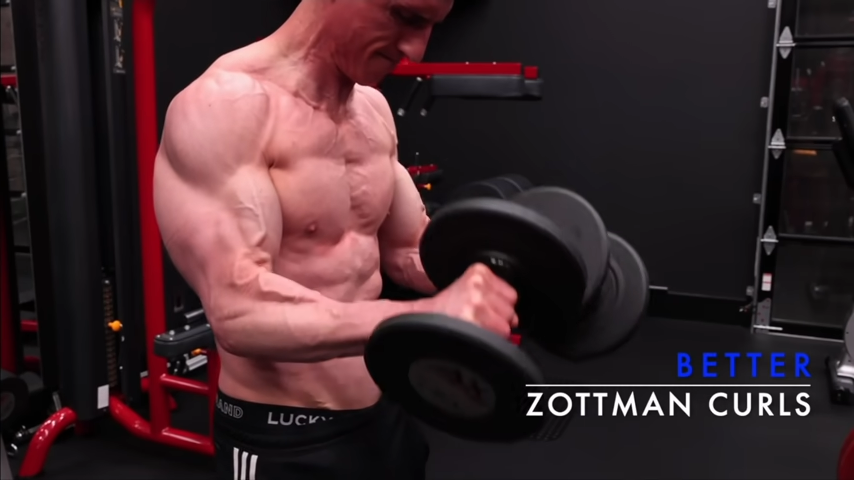
HOW TO DO THE ZOTTMAN CURL:
- Stand with your feet shoulder-width apart, holding a pair of dumbbells of weight suitable for your strength level.
- Ensure a proper starting position by keeping your core engaged, shoulders back, and arms fully extended at your sides.
- Begin by performing a Standard Dumbbell Curl. Lift the weights towards your shoulders with an underhand grip, focusing on elbow flexion and maintaining a slow, controlled movement.
- At the top of the curl, pause and rotate your wrists into a pronated position (palms facing down). This rotation is crucial for targeting different muscle fibers and engaging the brachioradialis muscles.
- Lower the weights back down slowly in this pronated position, keeping tension on the muscles throughout the entire curl.
- Once the dumbbells reach the bottom, rotate your wrists back to the starting underhand position and repeat the movement.
WHAT MAKES IT EFFECTIVE: Zottman Curls are a great exercise for bicep growth and forearm development because they combine the benefits of both Standard Curls and Reverse Curls. By incorporating wrist rotation, you maximize muscle recruitment and tension on the muscle fibers, leading to greater muscle stimulus and hypertrophy. This exercise is an excellent addition to any upper-body strength training routine, offering a comprehensive approach to arm strength and size.
BANDED DUMBBELL CURL


HOW TO DO THE BANDED DUMBBELL CURL
- Anchor a resistance band to a low, stable object. Stand about three feet away from the anchor point, adjusting for a challenging level of resistance.
- Grab a section of the band in each hand and hold a pair of dumbbells of weight suitable for your strength.
- Maintain a proper starting position with your feet shoulder-width apart and core engaged.
- Begin the curl by lifting and curling the dumbbells to shoulder height. Focus on maintaining tension on the band throughout the movement.
- Pause at the top of the curl, emphasizing muscle activation and ensuring a controlled motion on muscle development.
- Slowly lower the dumbbells back to the starting position, keeping tension on the band to maximize muscle stimulus and avoid any form breaks.
WHAT MAKES IT EFFECTIVE: This exercise is effective because it works active supination in a way other bicep curl variations do not, increasing peak muscular tension throughout the entire range of motion. By incorporating the band, you engage more muscle fibers and enhance the degree of muscle recruitment, making it a superior choice for bicep development and an excellent addition to your upper body strength training routines.
INCLINE DUMMBELL CURL


HOW TO DO THE INCLINE DUMBBELL CURL:
- Sit on an incline weight bench with the seat angled back to about 45 degrees.
- Hold a dumbbell in each hand, allowing your arms to hang down fully extended.
- Ensure your shoulder position is stable and your core is engaged to maintain proper form throughout the exercise.
- Begin the curl by slowly lifting the dumbbells, focusing on elbow flexion, and squeezing the biceps as they reach shoulder level.
- Pause at the top of the movement to maximize muscle stimulus and tension on the muscle fibers.
- Lower the dumbbells back to the original position in a controlled manner, emphasizing the stretch on the long head of the biceps.
- Squeeze the triceps at the bottom portion of the movement to ensure a full range of motion and proper muscle engagement.
WHAT MAKES IT EFFECTIVE: Incline Dumbbell Bicep Curls are highly effective because they target the biceps at the beginning portion of the strength curve, where the muscle is fully elongated. This position increases the degree of muscle recruitment, especially for the long head of the biceps, and enhances muscle tissue development.
NO MONEY CURL

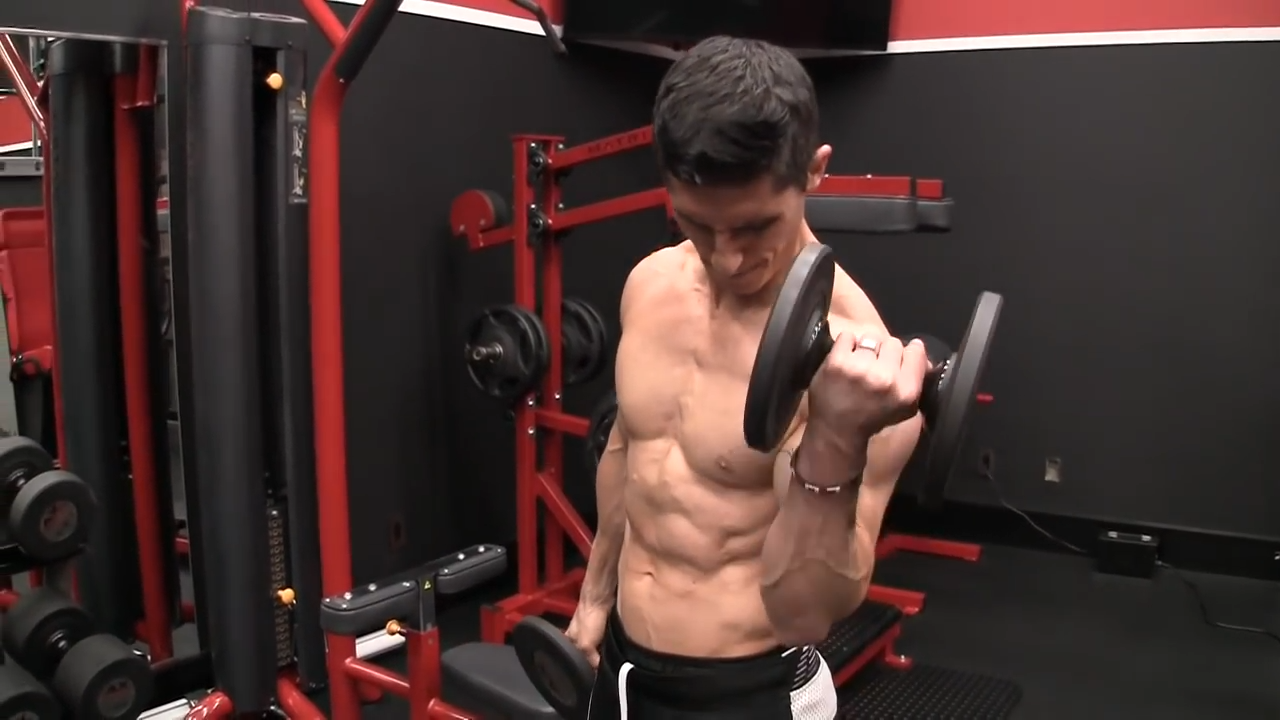
HOW TO DO THE NO MONEY CURL:
- Stand with your feet hip-width apart, holding a dumbbell in each hand.
- Ensure a proper starting position by engaging your core and keeping your posture straight.
- Bend your elbows and curl the weights towards your outer shoulders while externally rotating your wrists.
- Focus on the rotation to target the interior of the biceps muscle, specifically the short head.
- Alternate sides to ensure balanced muscle development.
- Maintain a slow and controlled body movement to maximize tension on the muscle and avoid potential injury.
- Ensure your shoulder position remains stable to prevent elbow issues and optimize the degree of muscle recruitment.
WHAT MAKES IT EFFECTIVE: The No Money Curl stands out from other popular biceps curl variations, including the Traditional Dumbbell Curl, due to its unique emphasis on shoulder external rotation. This rotation preferentially targets the short head of the biceps, enhancing muscle stimulus and development.
BARBELL CURL

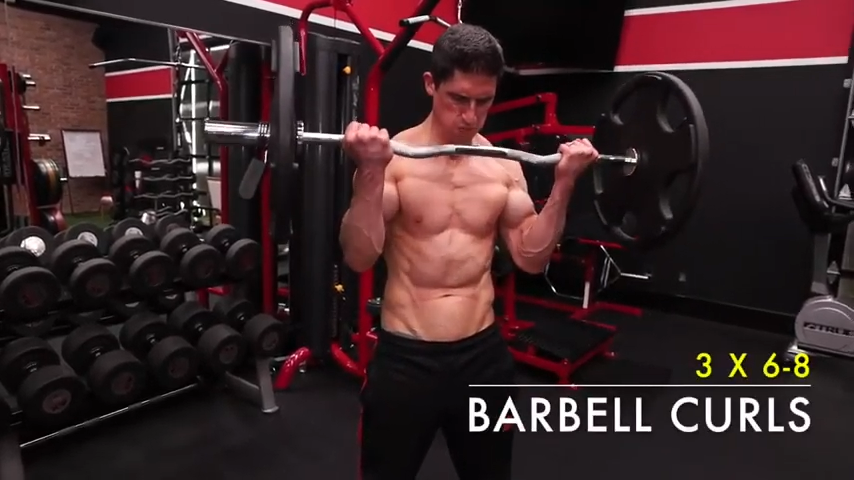
HOW TO DO THE BARBELL CURL:
- Begin by standing with your feet shoulder-width apart, holding a barbell with an underhand grip (palms facing up). This setup is crucial for performing 2-handed curls.
- Position your hands about shoulder-width apart on the barbell, ensuring a proper starting position with your elbows close to your torso.
- Start curling the barbell upwards by flexing your elbows. Focus on keeping the movement slow and controlled to maximize tension on the biceps throughout the entire curl.
- As you reach the mid-range of the curl, maintain your form, and ensure your elbows remain static to prevent any unnecessary body movement.
- At the top of the movement, your hands should be at shoulder height. Squeeze your biceps hard to emphasize muscle contraction and activation.
- Slowly lower the barbell back to the starting position. Keep the tension on your muscles by controlling the descent and avoiding any sudden drops.
- Ensure you complete the entire curl, from full extension at the bottom to full contraction at the top, to engage all muscle fibers effectively.
WHAT MAKES IT EFFECTIVE: Barbell Biceps Curls are a staple in upper-body strength training routines because they allow for significant weight load, promoting muscle hypertrophy and strength. By following proper barbell curl instructions, you ensure maximum muscle activation and growth. This exercise is a fundamental part of any comprehensive biceps workout, helping you build stronger, bigger biceps and enhancing your overall arm development.
WEIGHTED CHIN UP

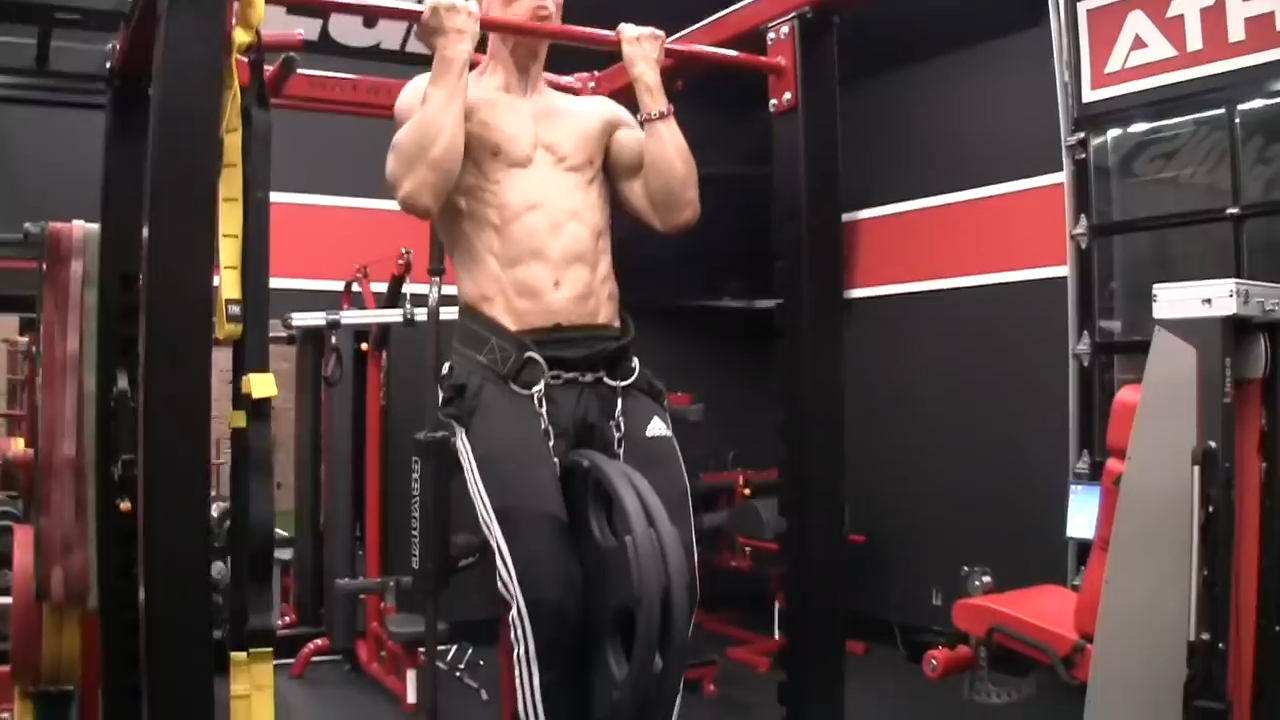
HOW TO DO THE WEIGHTED CHIN UP:
- Stand with your feet hip-width apart and grip the chin-up bar with your hands about shoulder-width apart, palms facing toward you. Attach a weight plate to your body securely.
- Engage your core and ensure you have a stable and proper starting position to avoid any form breaks or potential injury.
- Begin the motion by bending your elbows and pulling your body upward. Focus on elbow flexion and ensure your chin clears the bar.
- Maintain a controlled and slow body movement to maximize muscle activation and tension on muscle fibers.
- Reverse the movement slowly, lowering your body back to the starting position. Keep your core tight to prevent any sway or excessive motion.
- Throughout the entire curl, maintain a tight core and proper shoulder position to avoid strain on the elbow tendon and ensure effective muscle stimulus.
- Avoid common bicep curl mistakes such as using momentum or improper shoulder height. Focus on the entire range of motion to engage all relevant muscle tissue effectively.
WHAT MAKES IT EFFECTIVE: We take a classic body weight exercise and add weight to it to achieve overload in all three functions of the biceps. It’s also a great exercise for helping to build grip strength.
WORST BICEP CURL ALTERNATIVES
Not all curls are created equal. In fact, some exercises labeled as bicep curls or bicep builders are anything but.
Here are some of the worst offenders that you should avoid:
REVERSE CURLS

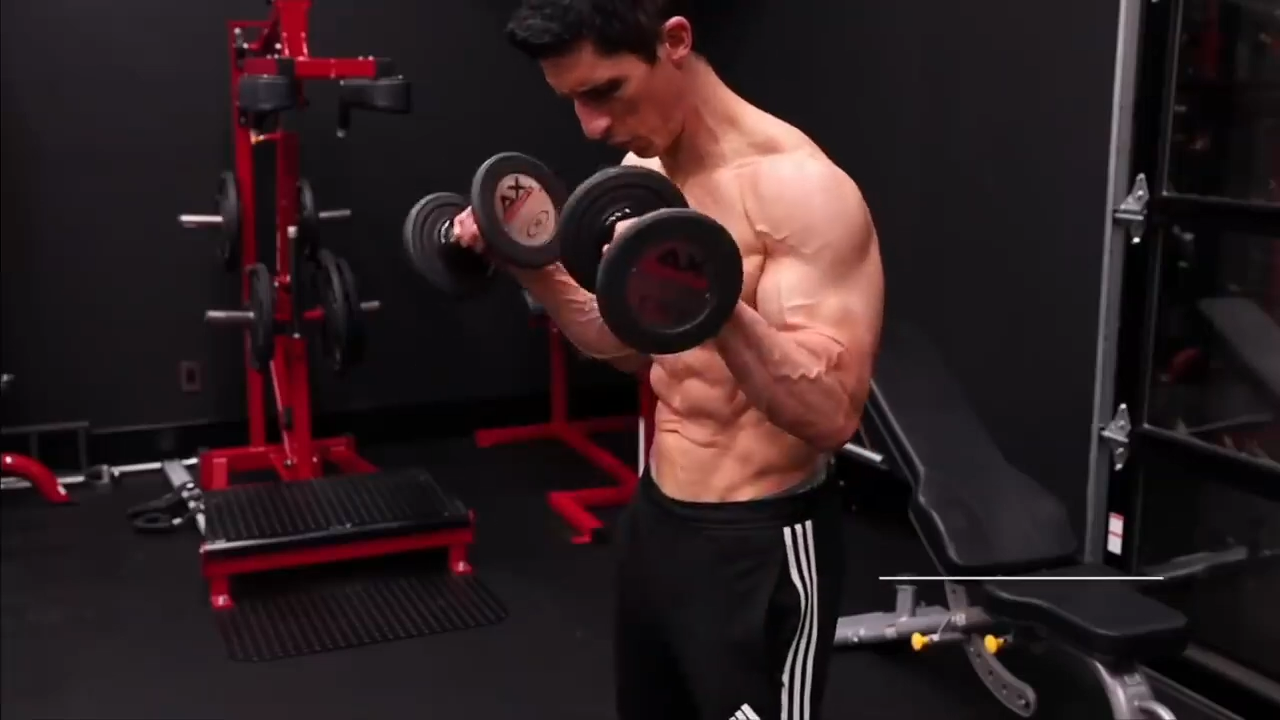
Reverse Curls are often mistaken for a bicep exercise, but they primarily target the brachialis muscle.
While the brachialis is important for overall arm development, calling Reverse Curls a bicep exercise is misleading.
If your goal is to isolate and build your biceps, Reverse Curls won’t deliver the results you’re after.
CONCENTRATION CURLS

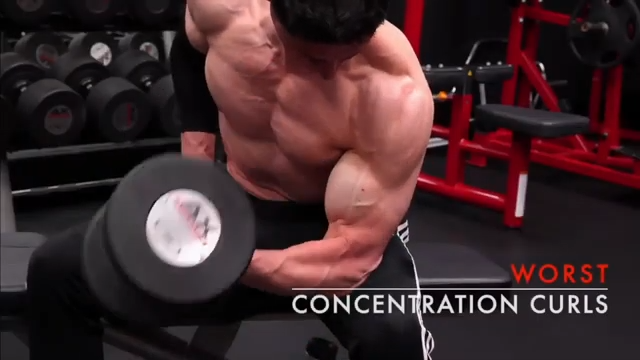
Concentration Curls can be an effective bicep exercise, but they are frequently performed incorrectly.
Most people place their elbow on top of their thigh, which compromises the position and reduces the activation of the biceps muscle.
This poor form shifts the focus away from the biceps, making the exercise less effective and potentially harmful if done repeatedly.
BICEPS PUSH-UP

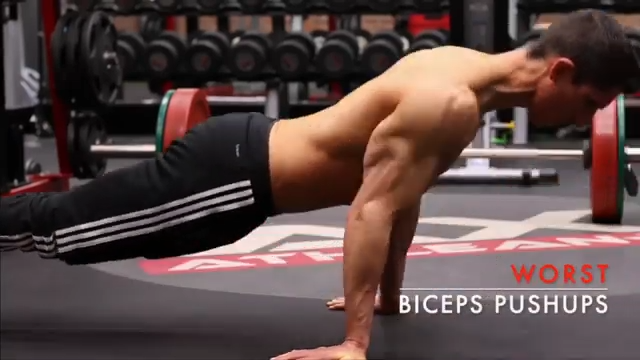
Let’s be clear: the Biceps Push-Up is a misnomer. It’s not a bicep exercise. It never has been and never will be.
The Biceps Push-Up is essentially a Push-Up, which targets your chest, triceps, and shoulders.
And the argument for eccentric overload here is weak.
This exercise just doesn’t effectively engage the biceps, and it’s misleading to include it in a bicep-building routine.
Guys, if you want bigger biceps, you need to do two things:
Make sure you’re performing the Biceps Curl correctly, and, just as importantly, you need to include some variety in your arm day program. If you’re having trouble creating an arm workout, we’ve got you covered! Check out our ATHLEAN-X programs to see which is the best fit for your goals and fitness level.

- Bicep Curls are a classic arm-building exercise that should be a staple in any workout.
- Here’s how to do Bicep Curls with correct form and technique:
- Position your feet hip-width apart to create a solid foundation.
- Grasp a pair of dumbbells with your palms facing up, extending your arms straight down in front of you. This is your standard curl position for Traditional Bicep Curls.
- Position your hands about shoulder-width apart.
- Keep your elbows close to your torso, ensuring they remain static throughout the movement to avoid any elbow issues.
- Maintain a straight posture with your chest up, engaging your abdominal muscles for stability. Proper starting position is crucial to prevent potential injury.
- Begin the curl by flexing your elbows, lifting the dumbbells towards your shoulders in a smooth, controlled motion. This initial phase should focus on elbow flexion to activate the biceps brachii.
- As you reach the mid-range of the curl, ensure your body movement remains slow and controlled. This phase emphasizes muscle activation and degree of muscle recruitment.
- Raise the dumbbells until your biceps are fully contracted and the weights are at shoulder height. Squeeze your biceps at the top of the movement to maximize muscle stimulus.
- Slowly lower the dumbbells back to the starting position, maintaining control to keep tension on the muscle fibers throughout the entire curl. This controlled descent is key to preventing form breaks.
HOW TO DO BICEP CURLS FAQS
Executing the perfect Bicep Curl is crucial for effective arm workouts.
Start by standing with your feet shoulder-width apart, holding a pair of dumbbells with an underhand grip, arms fully extended and palms facing forward.
Ensure your hands are shoulder-width apart and maintain a straight posture with your chest up and core engaged.
Flex your elbows and lift the weights towards your shoulders in a smooth, controlled motion. Avoid unnecessary body movement or swinging to keep the focus on the biceps.
In the mid-range of the curl, keep your elbows static and close to your torso to maintain tension on the biceps.
Avoid common mistakes like using excessive weight or improper shoulder position to prevent elbow issues and potential injury.
Raise the weights until your biceps are fully contracted and the dumbbells are at shoulder height, then squeeze your biceps at the top for maximum muscle stimulus.
Slowly lower the weights back to the starting position, maintaining control to keep tension on the muscle fibers.
Start with lighter weights to master the technique before progressing to medium-heavy weights, which helps avoid strain on the elbows.
Bicep Curls are a cornerstone exercise for building arm strength and size. By targeting the biceps brachii, this exercise helps enhance muscle hypertrophy and definition.
Incorporating bicep curls into your entire workout routine provides numerous benefits, including improved upper body strength, better muscle tone, and increased functional strength for everyday activities.
Muscle Development: Bicep Curls focus on the biceps brachii, promoting muscle growth and definition. Variations like Incline Barbell Curls and Dumbbell Preacher Curls can help target different parts of the biceps, ensuring comprehensive development.
Strength Building: Performing Bicep Curls with medium-heavy weight helps build significant strength in your arms, crucial for upper-body strength training routines. This strength translates into improved performance in other weight training exercises and functional movements.
Functional Benefits: Strong biceps are essential for daily activities that involve lifting, pulling, and carrying. Enhanced bicep strength improves your ability to perform tasks with ease, reducing the risk of arm injury and potential strain.
Prevention of Injuries: Strengthening the biceps through consistent practice of Bicep Curls helps stabilize the elbow joint and reduces the risk of elbow issues. This stability is vital for preventing potential injury during other exercises and daily activities.
Enhanced Aesthetics: Incorporating bicep curls into your 4-Move Workout or 15-minute dumbbell arm workout can significantly enhance the visual appeal of your arms. Well-developed biceps contribute to a more balanced and muscular physique.
Research-Backed: Studies published in the Journal of Strength and Conditioning Research highlight the effectiveness of the normal curl in promoting muscle growth and strength. This exercise remains a staple in upper-body strength training routines for its proven benefits.
One of the biggest mistakes people make when doing Bicep Curls is using too much weight and sacrificing form for ego. This error not only limits muscle growth but also puts you at serious risk for injury.
When you lift weights that are too heavy, you tend to recruit other muscles to help with the lift.
This means your shoulders start to move, your back begins to sway, and your elbows drift away from your torso.
These compensations take the tension off the biceps brachii, reducing the effectiveness of the exercise and putting unnecessary strain on other parts of your body.
Start with lighter weights that allow you to maintain proper form throughout the entire curl.
Focus on keeping your elbows close to your torso and ensuring your body remains static. The movement should be slow and controlled, emphasizing muscle activation and a full range of motion.
The short answer? No, you shouldn’t do bicep curls every day – no matter your curl of choice. Let’s break down why.
Muscle Recovery: Your muscles need time to recover and grow. When you work out, you’re actually causing tiny tears in the muscle fibers. It’s during the recovery period that your muscles repair and grow stronger. Training your biceps every day doesn't give them the necessary time to recover, which can lead to overtraining and hinder your progress.
Risk of Overuse Injuries: Repeatedly stressing the same muscles day after day increases the risk of overuse injuries. This can lead to elbow issues, tendonitis, and other joint problems. Incorporating rest days is crucial to prevent these potential injuries and ensure long-term joint health.
Balanced Training: Your workout routine should be balanced, hitting all major muscle groups. Focusing solely on biceps curls can create muscle imbalances, leading to poor posture and increased injury risk. A balanced routine that includes exercises for your chest, back, shoulders, and legs promotes overall muscle development and functional strength.
Optimized Growth: Research shows that muscles need about 48 hours to recover fully. Incorporate Regular Bicep Curls into your routine 2-3 times a week, combined with other upper body strength training exercises. This approach ensures your muscles get enough stimulus for growth while allowing adequate recovery time.
Variety and Adaptation: Mix up your bicep workouts with different types of Bicep Curls. This variety prevents plateaus, keeps your workouts interesting, and targets your biceps from different angles, promoting well-rounded growth.
REFERENCES

Jeff Cavaliere M.S.P.T, CSCS
Jeff Cavaliere is a Physical Therapist, Strength Coach and creator of the ATHLEAN-X Training Programs and ATHLEAN-Rx Supplements. He has a Masters in Physical Therapy (MSPT) and has worked as Head Physical Therapist for the New York Mets, as well as training many elite professional athletes in Major League Baseball, NFL, MMA and professional wrestling. His programs produce “next level” achievements in muscle size, strength and performance for professional athletes and anyone looking to build a muscular athletic physique.
















